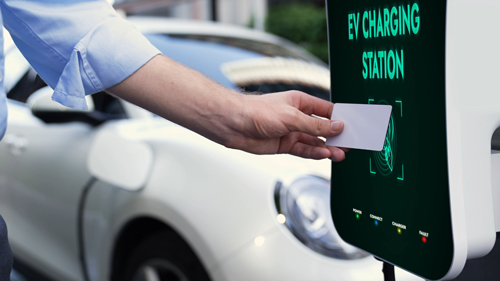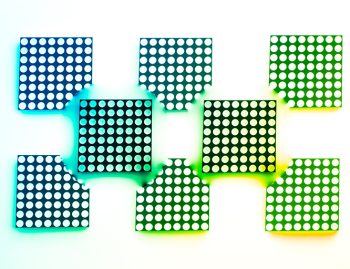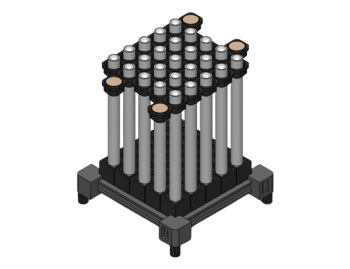
In this post, we’ll explore the evolving user interface (UI) designs of electric vehicle (EV) charging stations.
Because the idea of what an EV charging tower should look like has not yet been fully codified, designers are finding a great deal of latitude to experiment with the form factor, lights, and controls as well as new methods to convey diagnostic information.
User interface (UI) design elements for charge points have evolved quickly in just a few years. LEDs, whether as information indicators or as aesthetic accents have emerged as a common visual language in EV charging stations.
A Common Language for EV Charging Stations
Thus far in charging station design, a few prevalent human-machine interface (HMI) features have become familiar to EV users and therefore more or less standardized. All these features employ the use of light as a language to convey status information, guide the user through the charging process, and spotlight important aspects of the design.
Tower illumination
It is almost universally accepted that charging stations themselves exhibit a colored light, primarily to grab attention. This has a lot to do with the fact that charging locations are often not in prominent roadside positions. They may be relegated to the back of a parking lot and hard for drivers to locate. The brightness of this colored light is frequently quite intense, so that the lights are even noticeable in the daytime.
Tower design has evolved to incorporate logos, unusual forms, and creative LED accents, all of which have become ways of distinguishing a brand.
User authentication
The first action upon arrival at the charge point is to authorize a transaction, most often through an LED-lit touchscreen on the side or front of the tower.
Interactive touchscreens featuring LED-lit touch controls facilitate user authentication and payment processes. A multi-screen interface using progressive disclosure allows the driver to select language, payment options, credit card processing, power output, and charging progress.
The touch interface typically reminds the user to unplug and put the cable back in its rack once the charging is complete.
Charging port illumination
LED lights embedded around the charging port on the vehicle itself provide clear visibility for the user to engage charging, even in low-light conditions. A change in LED color lets the user know a proper connection has been made. It is the most immediate location for signifying charging status — typically green for available, blue for charging, and red for faults.
DC charging stations with removable cables may have a similar LED engagement indicator around the output port of the console.
Cable management
EV charging stations often incorporate LED-lit cable holders that guide users on proper cable placement. The lights activate when the cable is securely positioned. Cables on the ground could pose a tripping hazard or get run over by vehicles, so cable management has become a significant safety concern.
Charging speed indication
The LED rings encircling the charging connector illuminate in varying colors or blinking rhythms corresponding to charging speeds. This visual feedback is the most immediate and intuitive method of showing the rate of recharge. Users can see the indicator from a distance and from different vantage points.
Creating Reliable and Intense LED Effects
Communicating the logic of the indictor data to design engineers is simple enough, but there are some constraints to designing with light. These stem from other engineering objectives in EV charging, such as:
- Safety: Ideally, circuitry and conductive materials should be kept a safe distance from the user. Especially since we are dealing with high voltage electricity, users need to be insulated from possible accidental conductance. Therefore, LEDs themselves should not be mounted at the surface of control or indicator panels.
- Hue and intensity: No one wants dim LEDs, causing the user to wonder “is this charging?” Also, if multiple colors are used for indication, designers want to avoid color bleeding, which results in a polluted hue.
- Weather-resistance: Casing and seals must be waterproof and shock resistant. Again, in line with #1, we don’t want to mix water and high-voltage electricity.
The relatively recent hardware innovation to solve these problems is to employ light pipes. Essentially, light pipes are reflective conduits that can move light from LEDs mounted on the printed circuit board (PCB) to the surface lens with minimal loss. These components allow for the PCB to be a safe distance from the user controls.
Rigid light pipes from Bivar, are common components installed in EV chargers. For instance, Bivar’s LPV — a ZeroLightBleed™ surface mount adapter with built-in SMD LED and vertical light pipes — prevents light interference and also ensures bright and accurate colors.
Sealed light pipe assemblies also provide the appropriate ingress protection (IP) ratings which is necessary for devices in a rugged outdoor environment. Both rigid and flexible light pipes include IP67 rating options which protect against harsh elements such as liquids, dust, and airborne particles. For precise fit and effective seals, the Bivar engineering team builds and tests custom designs based on customer requirements, or designers can employ a modular light pipe system.
The Future Looks Bright
The evolution of UI for EV charging has not slowed down. In fact, other capabilities and novel design features are on the horizon, as providers continue to compete for EV customers.
Some emerging designs experiment with LED progress bars that wrap around the charging port — much like the charging speed indicator — and provide a live visual representation of the charging process. Other prototypes incorporate interactive gesture controls through motion sensors. A simple hand wave could activate or deactivate the charging process. And even more futuristically, LED-driven holographic projections are being explored to overlay charging instructions, FAQs, and safety guidelines.
With these concepts in the pipeline, it is anyone’s guess what an EV charging station might look like in ten years.
One constant in this area of UI design, however, appears to be the bold and creative use of LED light.
Learn more about Bivar light pipes for automotive applications.














